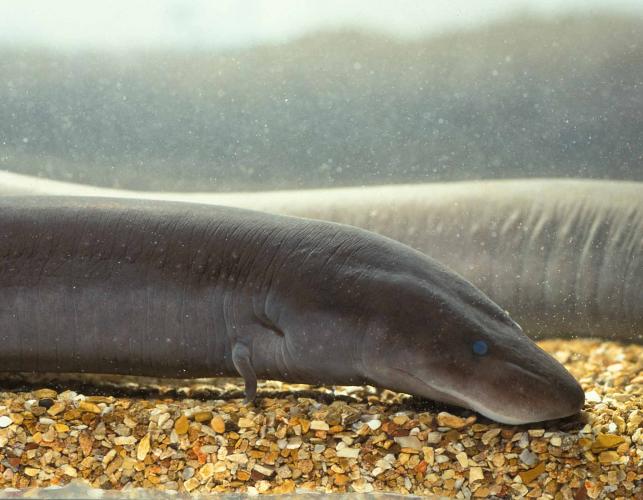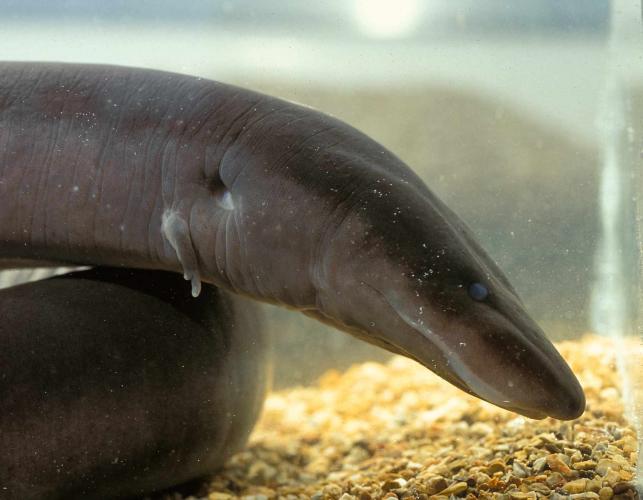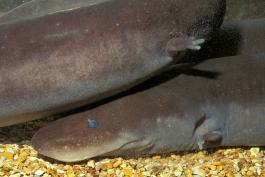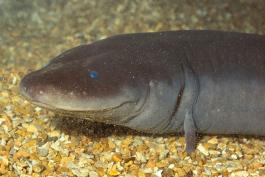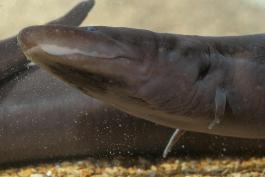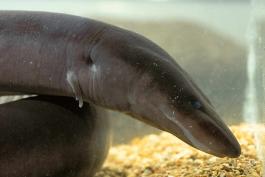
The three-toed amphiuma is a completely aquatic salamander shaped like a long cylinder with a somewhat pointed head; it has tiny, gray, lidless eyes and very small forelimbs and hind limbs. Each limb has three very small toes. Many specimens, however, may be missing toes, limbs, or both. The color above is dark brown or black; the belly is lighter brown or gray. The throat has a dark patch. Adults do not have gills, but a gill slit is present on each side of the head. Amphiumas have lungs and must breathe air at the surface of the water.
Amphiumas are alert, fast, and slippery and may bite viciously if captured.
Similar species: The western lesser siren (Siren intermedia nettingi) has feathery external gills and lacks hind limbs; in Missouri, its range extends farther north and east than the amphiuma’s. Both of these salamanders can be distinguished from eels and lampreys (which are fish) by their limbs with fingers, tiny eyes, and lack of fins and scales.
Adult length: 18–30 inches; occasionally to more than 40 inches.

The Mississippi Alluvial Basin of southeastern Missouri.
Habitat and Conservation
This salamander lives in semipermanent to permanent aquatic habitats such as ditches, sloughs, sluggish streams, and swamps. In Missouri, it prefers cypress swamps.
Amphiumas are secretive and spend daylight hours buried in muck or hiding in holes or under submerged roots, debris, or aquatic plants. Their heads and necks may be exposed, and periodically they must come to the surface for air. They forage at night.
During droughtlike conditions, amphiumas burrow into soft muck or move into crayfish burrows to escape desiccation and can live for many months without food.
They crawl overland on nights with heavy rains.
Food
Amphiumas venture forth at night in search of small fish, crayfish, tadpoles, snails, aquatic insects, earthworms, and other aquatic animals.
Status
A species of conservation concern in Missouri. The cypress swamps of southeastern Missouri are important to the survival of this interesting amphibian and should be protected. Only a small fraction of Missouri’s original cypress swamps remain.
This species is sometimes called “congo eel,” “blue eel,” and “ditch eel,” but it is not a true eel, since eels are fish, and amphiumas are amphibians.
Life Cycle
In Missouri, breeding apparently occurs in late summer and early autumn. Females generally produce a clutch of eggs every other year. The females court males. A female generally lays an average of 200 eggs on land, usually under a rotten log near water, and the female stays with the eggs until they hatch, about 4 or 5 months later. In Missouri, egg-laying likely occurs during late summer. Once water from autumn rains covers the eggs, they complete their development and hatch. The larvae are gilled but take air from the surface, so they apparently have well-developed lungs upon hatching. The gills are resorbed within about 3 weeks after hatching. Amphiumas reach sexual maturity at about 3 or 4 years of age and can live for more than 12 years.
Human Connections
If you are fishing and catch an amphiuma, or any other amphibian, cut the line and release it unharmed. Most amphibian populations are declining, none are venomous, and none threaten our fisheries. They are an integral part of our aquatic fauna.
Ecosystem Connections
The western mudsnake of southeastern Missouri specializes in eating our two eel-like amphibians (the amphiuma and the lesser siren). The slippery amphibian thrashes wildly, but the snake pokes its prey with its pointy tail tip. This makes the amphibian uncurl and easier to swallow.
